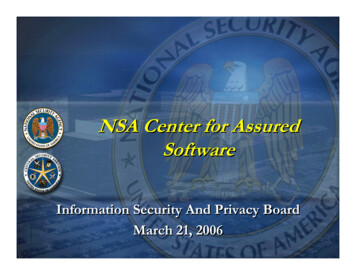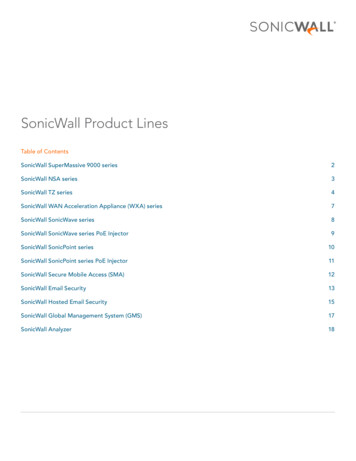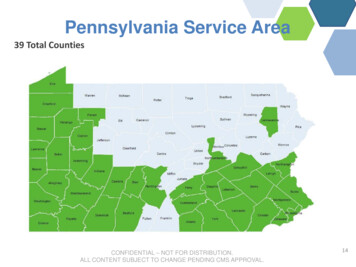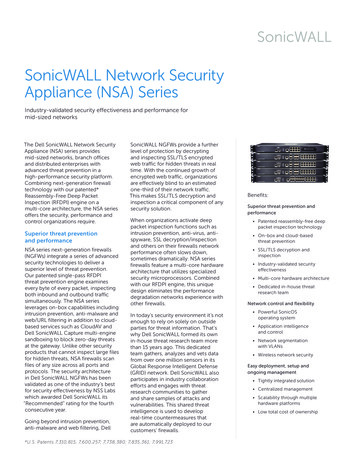
Transcription
NSA Center for AssuredSoftwareInformation Security And Privacy BoardMarch 21, 2006
Software AssuranceDefinitionDoD Software Assurance InitiativeDoD Software Assurance Tiger Team The level of confidence that software is free ofexploitable vulnerabilities, either intentionallydesigned into the software or accidentally inserted And that the software functions in a manner asexpected.
Problem Statement (1)“The ubiquity of software and itsdevelopment and usage without consistentengineering, has resulted in ad hocmanagement and mitigation efforts in a raceto protect systems against breaches”NII SponsoredSoftware Assurance Tiger Team
Problem Statement (2)There’s too much softwareThere’s too little assurance
DoD SwA CONOPS: InteractingProcesses
Science & Technology Provide software evaluation services Use tools to detect vulnerabilities Coordinate DoD R&D for vulnerability detectionand mitigation Work with industry to develop standards/solutions Recommended a DoD Executive Agent forSoftware Vulnerability Mitigation and Discovery– Establish a DoD Center for Assured Software
NSA Center for Assured Software(CAS) Stood up in November, 2005 A Focal Point for Software Assurance (SwA) Issueswith the following objectives:– Partner with our customers, government, theprivate sector and academia to identify SwAIssues and resolutions– Develop and utilize tools and methods to analyzethe trustworthiness of software
NSA Center for Assured Software(CAS) (cont) Objectives (cont)– Evaluate mission critical components– Establish/Identify software standards andpractices to increase the availability of assuredsoftware products
CAS “domain of operation”Role of Formal MethodsDevelopmental ProcessesBinary analysis tools/techniquesSource Code analysis tools/techniquesStatic/Dynamic analysisProduct EvaluationRequirements Design Implementation Testing Deploy MaintenanceSafe Language StandardsDevelopment Tools/techniques
What we look like today NSA Center for Assured SoftwareStandardsOutreachTools and TechniquesEvaluationsNIAPSwAE
Where we are working today NIAP– Fully operational– Beginning to address recommendations from theGAO and IDA NIAP review reports Software Assurance Evaluations– Are evaluating some specific software of interestto NSA in the context of a pilot First report due in 30 days
Where we are working today (cont) A repeatable SwAE methodology based upon availabletools– Involves a tools survey as wells as incorporating lessonslearned from our pilot Strategies for :– Public Software Assurance Standards participation– Internal NSA Software Assurance Standards andcompliance– Outreach– High Assurance
Using Tools for to gainConfidence in Software
Measuring Software Assurance Looking for properties of software that areindicators of the assurance level– Degree of confidence that software will securelyand appropriately perform its intended functions– Degree of confidence that software will notperform any unauthorized functions– Degree of confidence that software does notcontain implementation flaws that could beexploited.
Measuring Software AssuranceProcess Phases: Acceptance Extraction/Inspection Analysis Meta-Analysis Reporting
Acceptance Are there existing tools and techniques that addressthe software to be evaluated?– Platform/Machine Language x86, Sparc, ARM, etc.– Source Language C/C , Java, Microcode, etc.– File Format PE, ELF, ROM Image, etc.– Environment Windows, Real-time O/S, Linux
Measuring Software AssurancePhase Report Card:C Acceptance Extraction/Inspection Analysis Meta-Analysis ReportingCAS: Identify and fillcapability gaps
Extraction/Inspection Apply tools and techniques that extract relevantmetadata from the software– Control Flow Graphs– Complexity Metrics– Module Dependencies– Disassembly/Decompilation– Functional Extraction– Instruction Effects Analysis– Identification of Code vs. Data
Extraction/Inspection Extraction/Inspection tools are the mostsophisticated tools available today– Most academic and commercial research anddevelopment is in this area– Much of the research is driven by the need to portlegacy applications to newer platforms and binaryformats
Extraction/Inspection Extraction/Inspection tools have complex output– Use requires a high level of training Tool results create the environment for analysis, butin most cases only indirectly indicate assurance Integration of extraction/inspection tools withanalysis tools is poor– Metadata formats are typically proprietary withspecialized programming interfacesSample tool output
Extraction/Inspection
Extraction/Inspection
Extraction/Inspection
Extraction/Inspection
Measuring Software AssurancePhase Report Card:C B Acceptance Extraction/Inspection Analysis Meta-Analysis ReportingCAS: Identify and fillcapability gapsCAS: Foster integrationand promote furtherresearch
Analysis Apply tools and techniques that query the metadatafor properties or indicators of assurance– Existence of Buffer Overflows– Improper Memory Management/Object Reuse– Insecure Storage of Cryptographic Keys– Lack of Authentication– Race conditions– Covert Channels– Unexpected Functionality
Analysis Existing analytical tools:– Relatively primitive– Typically tailored to a specific sets of bugs Not easily modified to address new questions– Typically highly coupled to a particularextraction/inspection tool Simple analytic capability carries with it thecost of sophisticated tool– Lots and lots of false positives
Analysis Analysts typically create small programs on the flyto answer specific questions– Custom tools generally aren’t refined to cover allrelevant cases– Limited distribution and support of tool– Tools themselves are not well-engineered orextensible– No integration into an overall evaluationmethodology
Measuring Software AssurancePhase Report Card:C B C- Acceptance Extraction/Inspection Analysis Meta-Analysis ReportingCAS: Identify and fillcapability gapsCAS: Foster integrationand promote furtherresearchCAS: Generate qualitytools, reduce falsepositives
Meta-Analysis Integrate output from multiple analytical tools andtechniques to discern higher-order assuranceindicators– Some tools may increase the confidence in theresults from another tool– Use one tool to focus the analysis of a followingtool or filter the results of a preceding tool– Independent indicators help rank results– Perform analytical tests not within the capability ofany one tool
Meta-Analysis No technological methodology currently exists that:– Leverages the strengths of multiple tools– Contains the technological “glue” to connecttools from different vendors– Models software assurance through a diverse setof direct and indirect indicators– Is repeatable, scalable, and well-documented
Measuring Software AssurancePhase Report Card:C B CI Acceptance Extraction/Inspection Analysis Meta-Analysis ReportingCAS: Identify and fillcapability gapsCAS: Foster integrationand promote furtherresearchCAS: Generate qualitytools, reduce falsepositivesCAS: Weave tools into ascalable methodology
Reporting Transform analytical results into comprehensiblereports– Ranked “raw” data for follow-on deep analysis– Comparative results for systems design decisions– Summary results linked to standardized evaluationcriteria for use as part of a larger evaluation process– Formal evaluation report for technology-onlyevaluations Report formats are not currently defined
Measuring Software AssurancePhase Report Card:C B Acceptance Extraction/InspectionI Analysis Meta-AnalysisI ReportingC-CAS: Identify and fillcapability gapsCAS: Foster integrationand promote furtherresearchCAS: Generate qualitytools, reduce falsepositivesCAS: Weave tools into ascalable methodologyCAS: Define customerfocused report formats
Center for Assured SoftwareKris BrittonTD, NSA Center for Assured Softwarerkbritt@missi.ncsc.mil410-854-4543
NSA Center for Assured Software (CAS) NSA Center for Assured Software (CAS) Stood up in November, 2005 A Focal Point for Software Assurance (SwA) Issues with the following objectives: - Partner with our customers, government, the private sector and academia to identify SwA Issues and resolutions - Develop and utilize tools and .










